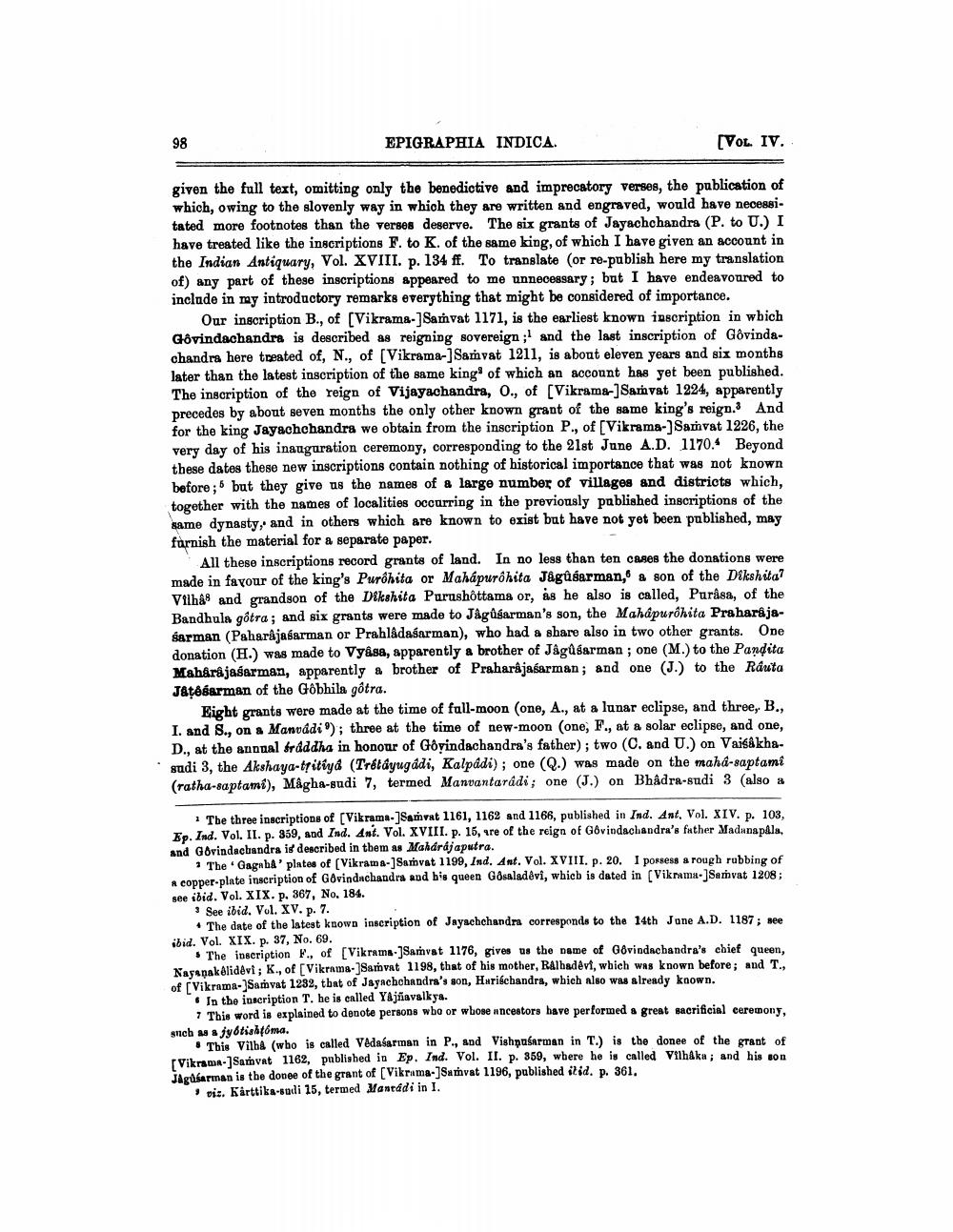________________
EPIGRAPHIA INDICA.
[VOL. IV.
given the full text, omitting only the benedictive and imprecatory verses, the publication of which, owing to the slovenly way in which they are written and engraved, would have necessitated more footnotes than the verses deserve. The six grants of Jayachchandra (P. to U.) I have treated like the inscriptions F. to K. of the same king, of which I have given an account in the Indian Antiquary, Vol. XVIII. p. 134 ff. To translate (or re-publish here my translation of) any part of these inscriptions appeared to me unnecessary; but I have endeavoured to include in my introductory remarks everything that might be considered of importance.
Our inscription B., of (Vikrama-] Samvat 1171, is the earliest known inscription in which Govindachandra is described as reigning sovereign ;' and the last inscription of Gôvindachandra here treated of, N., of Vikrama-] Samvat 1211, is about eleven years and six months later than the latest inscription of the same king of which an account has yet been published. The inscription of the reign of Vijayachandra, O., of [Vikrama-] Sarhvat 1224, apparently precedes by about seven months the only other known grant of the same king's reign. And for the king Jayachchandra we obtain from the inscription P., of [Vikrama-) Samvat 1226, the very day of his inauguration ceremony, corresponding to the 21st June A.D. 1170. Beyond these dates these new inscriptions contain nothing of historical importance that was not known before; 5 but they give us the names of a large number of villages and districts which, together with the names of localities occurring in the previously published inscriptions of the same dynasty, and in others which are known to exist but have not yet been published, may furnish the material for a separate paper.
All these inscriptions record grants of land. In no less than ten cases the donations were made in favour of the king's Purohita or Mahápurohita Jågûserman, a son of the Dikshita? Vilhas and grandson of the Dikshita Purushottama or, Ås he also is called, Purâsa, of the Bandhula gôtra ; and six grants were made to Jágúsarman's son, the Mahapuróhita Praharajasarman (Paharajasarman or Prahladaśarman), who had a share also in two other grants. One donation (H.) was made to Vyasa, apparently a brother of Jågūšarman ; one (M.) to the Pandita Maharajaśarman, apparently & brother of Praharajasarman; and one (J.) to the Rauta Jaţésarman of the Gobhila gôtra.
Eight grants were made at the time of full-moon (one, A., at a lunar eclipse, and three, B., I. and S., on a Manvadi"); three at the time of new-moon (one, F., at a solar eclipse, and one, D., at the annual braddha in honour of Gôyindachandra's father); two (C. and U.) on Vaisakhasudi 3, the Akshaya-tfitiya (Trétáyugádi, Kalpadi); one (Q.) was made on the maha-saptami (ratha-saptami), Magha-sudi 7, termed Manvantarádi; one (J.) on Bhadra-sudi 3 (also a
The three inscriptions of (Vikrama-]Samvat 1161, 1162 and 1166, published in Ind. Ant. Vol. XIV. p. 103, Ep. Ind. Vol. II. p. 359, and Ind. Ant. Vol. XVIII. p. 15, are of the reign of Govindachandra's father Madunapala, and Govindachandra i described in them as Mahdrájaputra.
1 The Gagaba' plates of (Vikram 8-]Samvat 1199, Ind. Ant. Vol. XVIII. p. 20. I porsess a rough rubbing of A copper-plate inscription of Govindachandra and bis queen Gosaladevi, whicb is dated in (Vikram-]Sarnvat 1208; see ibid. Vol. XIX. p. 367, No. 184.
* See ibid. Vol. XV. p. 7.
* The date of the latest known inscription of Jayachchandra corresponds to the 14th Jane A.D. 1187; see ibid. Vol. XIX. p. 37, No. 69.
The inscription .. of [Vikratna-]Samvat 1176, gives us the name of Govindacbandra's chief queen, Kasapakalidevi; K., of [Vikrama-Samvat 1198, that of his mother, RAlhadevi, which was known before; and T.. of rivikrama-Samvat 1282, tbat of Jayachchandra's son, Hurifchandra, which also was already known.
. In the inscription T. he is called Yajiavalkya.
7 This word is explained to denote persons who or whose ancestors have performed a great sacrificial ceremony. sneh wa jyotishgoma.
This Vilba (who is called Vedasarman in P., and Vishnusarman in T.) is the donee of the grant of Vikrama-Samvat 1162, published in Ep. Ind. Vol. II. p. 350, where he is called VilhAku; and his son Jaguarman is the donee of the grant of (Vikrama]Sumhvat 1196, published ibid. p. 361,
• pis. Kirttika-sodi 15, termed Masrádi in I.




